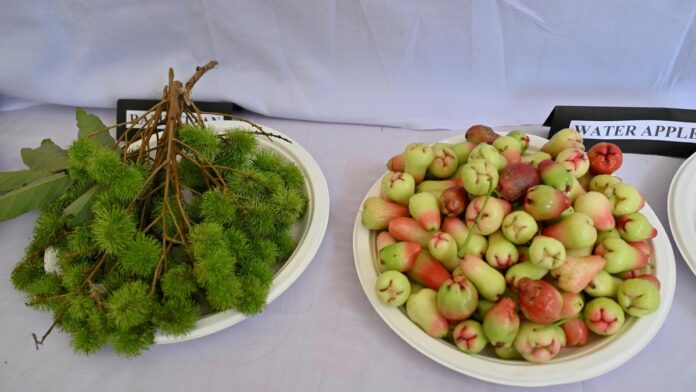
When the British settled in the Nilgiris, Coonoor, Kateri, Kotagiri, the slopes round Kalhatti, and the higher parts of Ootacamund were found suitable for apple cultivation since frost did not settle there.
| Photo Credit: M. Sathyamoorthy
The Nilgiris is synonymous with the Ooty apple. The fruit, known for its numerous health benefits, was introduced by the British who settled in the Nilgiris. Though suited to the climate of the Nilgiris, the cultivation of the fruit went through trials and tribulations.
W. Francis, the British officer who authored the Gazette of the Nilgiris, says that English fruit trees were imported to the Nilgiris almost as soon as the first Europeans settled there. But no systematic record survives of the varieties that were tried or the success each achieved. But records of the proceedings of the Nilgiris Agri-horticultural Society for March 1902 offers some insights into the subject. It was prepared by British officials General Morgan, Sir Frederic Price, and General Baker. The first person to succeed in cultivating the fruit was John Davison, a gardener trained at Kew in England. He was also said to have introduced pippin, which is now so common on the hills and is quite acclimatised.
A ‘handsome’ fruit
“The fruit of this is a handsome apple which frequently weighs over a pound and varies in colour from yellow streaked with red to a brilliant scarlet. Grafted on the crab stock, it thrives vigorously and bears heavily in situations above 5,000 feet in elevation. It is best grown in bush form,” writes Francis about apples and the import and cultivation of other fruits.
M. Narasimham, former Head of the Department of Botany, Madras Christian College, said almost 30% of the flora in the Nilgiris were exotic species. “The British introduced fruits and other plants for their requirements,” he said.
Places such as Coonoor, Kateri, Kotagiri, the slopes round Kalhatti, and the higher parts of Ootacamund suited the apple since frost did not settle there. Excellent varieties were raised by General Baker at Tudor Hall and General Morgan at Snowdon. The Badagas also planted numerous patches of pippin in these areas.
Threat from a pest
But the orchards faced a major threat from American aphid, an insect which affected not only the branches but also the roots. The pest killed the whole orchard. There was no cure, and the whole trees affected by the insects were to be burned. Francis says the pest spread easily by the clothes of the coolies working among the trees, by Sambhar, by grafts from the infected trees, and even by fruits being hawked. The situation deterred many from growing the tree. One of the reasons for the spread of the pest was failure to disinfect the plants when they were brought from England. Subsequently, fresh stocks from Australia, with certificates testifying that the plants had been disinfected with hydrocyanic acid gas, were obtained for a small fee.
Another disease that blighted the orchards was canker, “which generally starts at the collar and is usually caused by excess of manure, by the roots getting down into a cold subsoil, or by the bark being injured by the careless use of mamuti (a garden implement) when weeding. It was checked by cutting out the diseased part and painting the wound with grafting wax or ordinary oil paint,” writes Francis.
Velvet apples on display at Sims Park, Coonoor, during the Fruit Show held in May this year.
| Photo Credit:
M. Sathyamoorthy
Australian apples thrived well at Downham and the best varieties were Margil, Devonshire Quarrenden, Adams Pearmain, and Ecklinvile Seedling. The trees, which winter from December to the end of February, are pruned and winter-sprayed in January. They ripen in July and August. According to Francis, the trees required root-pruning, more often than in England, and summer pinching or stopping in July because of the climate.
Francis says pears also matched apples, but took longer to come into bearing. The best stock, according to Francis, is the China pear, which is generally known in the Nilgiris as the country pear. The Williams’ bon chrétien pear is a large pear and very highly flavoured. But, like Jargonelle, another variety, it does not keep well. A pear, known as Keiffer or Bartlett, which was grown very largely in America for canning, was introduced from Saharanpur. Louise Bonne of Jersey and Beurre Diel, all imported from Australia, promised well at Downham.
Medlars did well at Downham
Medlars grew well at Downham and quince in almost all parts of the hills. Peaches were raised from the stone. The plants were imported from England and generally grafted and budded on the almond or plum stock and failed to thrive.
Again good varieties of peaches imported from Australia — Red Shanghai, Carmen, Gros Mignon, and Emma — suited well to the area. Plums and apricots were the other fruits cultivated on the hills. George Oakes and Charles Gray imported the famous Japanese flowering cherries in 1906. The Himalayan Cherry was common in Coonoor, but its fruits were extremely acidic. Oakes also brought gooseberries from England. Raspberries were imported and the red variety was plentiful in Ooty, writes Francis.
Tea displaces apple
A combination of factors, including disease and increasing labour cost, has led to the gradual disappearance of apple orchards in the last four decades. Local historians claim that a gradual shift in consumer preference — for fruits imported from other parts of the world — broke the back of the apple-growers in the Nilgiris as cultivation became unviable. Gradually, apple and orange orchards were replaced with tea plantations since the 1970s and the 1980s.
(With inputs from Rohan Premkumar)
#trials #tribulations #apples #imported #fruits #Nilgiris
